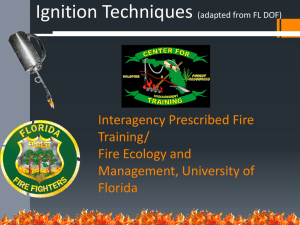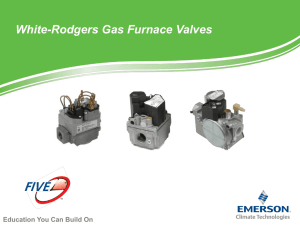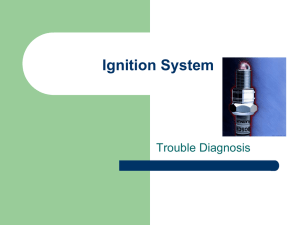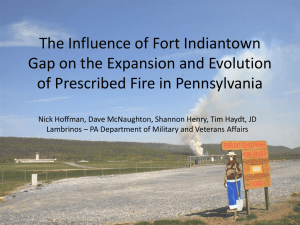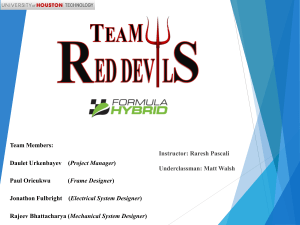Hot Surface Ignition of Combustible Fuels
advertisement
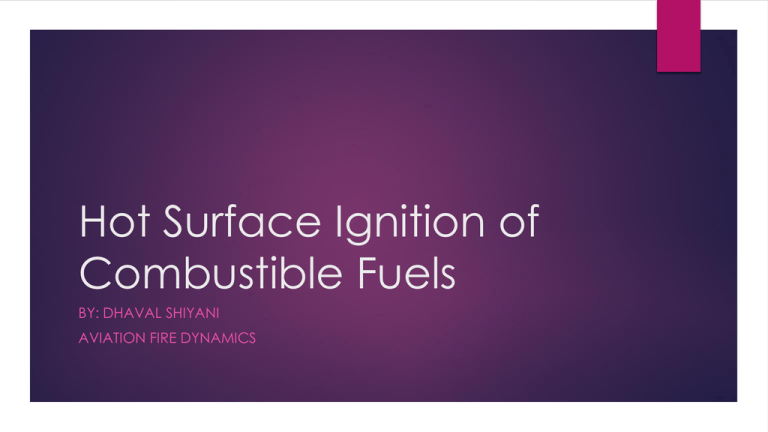
Hot Surface Ignition of Combustible Fuels BY: DHAVAL SHIYANI AVIATION FIRE DYNAMICS Outline Introduction Background Mechanism of Ignition Experimental Techniques Factors affecting Hot Surface Ignition Computational Results Summary Introduction Aviation, Automobile, Industrial machinery fires may be majorly attributed to leakage of flammable fluids onto hot surfaces, causing it to ignite Most of the designs use the minimum Auto Ignition Temperature (AIT) provided by ASTM to prevent such hot surface ignition accidents However it is experimentally found that the actual Minimum Hot Surface Ignition temperature of fuels is much greater than the Minimum AIT (Reasons discussed later) More data is required to better understand the flow mechanism governing this type of ignition to prevent such fires Background Auto Ignition Temperature (AIT): A fluid's AIT is that temperature at which its vapors will ignite in air at atmospheric pressure without an external source of ignition. [1][2][3][4][9] Thermal Ignition: Thermal Ignition of a flammable mixture of fuel and air occurs when the heat release from chemical reactions exceeds the heat loss such that the mixture becomes self-heating [1]. In other words it is the process of flame initiation [9] Flames, in most cases, are defined as highly exothermic reactions between fuel vapors (or gases) and an oxidant (in this case, oxygen) resulting in both the rapid generation of combustion products at relatively high temperatures (generally above about 11000C) and the emission of light. [9] Background Hot Surface Ignition Temperature (HSIT): It is the lowest temperature at which a specified hot surface will ignite a droplet of fuel that falls upon it. It is an auto ignition related phenomena [7] HSIT and AIT are not always the same. In fact as it turns out from experiments, HSIT is greater than AIT (in some cases more than 1000C greater) HSIT is greater than AIT because of the uncontrolled loss of vapor and heat after the droplet hits the surface [7] Because reaction rates are strongly temperature dependent, once self heating occurs the reaction rate rapidly increases and a flame front propagates away from the point of ignition [1] Background The flash point and the minimum auto ignition temperature are well defined properties that can be measured with ASTM standards Unlike them, the temperature at which hot surface ignition occurs is not a fundamental fluid property and is strongly coupled with numerous factors [1] Because of this coupling the temperature required for ignition can vary widely Background Hot surface ignition is further complicated because liquid fuel is often dispensed directly onto the hot surface, which makes the flow non uniform and turbulent in most cases Since a portion of the fuel must be evaporated and come into contact with the hot surface such that sufficient heat transfer can occur, ignition is directly coupled with these complex phenomenon Mechanism of Ignition To understand the mechanism of ignition due to a hot surface, we can divide the study into two types of different modes which work together to lead to an ignition, i.e.: Boiling modes Ignition modes Boiling Modes From the tests performed in by Bennett and Ballal (2003), three different boiling modes are observed for a combustible fuel over a hot surface: Nucleate Boiling Transition Boiling Film Boiling Nucleate Boiling Features observed during Nucleate boiling: Intensive bubbling of the liquid pool on the plate surface Slow expansion due to no vapor barrier to reduce friction Heavy vapor formation Frequently loud sizzling sounds to accompany the rapid vaporization This mode occasionally features a rapid explosion (disintegration) of pools and globules that go in all directions Such intense activities are observed at the highest temperatures and is defined by some as the “maximum evaporation mode” Transition Boiling Observed at plate temperatures above nucleate boiling A hybrid scenario which exhibits quicker liquid pool movement due to the formation of some vapor underneath Also an establishment of curvature of the pool leading edge due to surface tension is observed This mode has reduced nucleate bubbles in the leading edge perimeter, pool center, or dispersed when compared to nucleate boiling Film Boiling This type of boiling is observed at temperatures above transition boiling This mode exhibits complete lifting of the pool off the heated plate surface Which facilitates in rapid transfer of liquid to the plate edge and little to no nucleate bubbles Also this mode often exhibits breakup of the pool into smaller globules due to surface tension of the liquid Boiling modes vs. plate temperature Here is shown a comparison of the boiling modes vs. plate temperature for three fuels, viz. Hexadecane, heptane and kerosene [5] Ignition Modes The ignition modes are classified into three types by Bennett and Ballal (2003) They are; Hood Fires (unique to the constraints of fume hood apparatus detailed ref [5] ) Gutter Fires Airborne Fires Hood Fires This mode is commonly observed at the lowest plate temperatures In this mode, the fuel does not ignite until it reaches the plate perimeter However, ingestion of fresh air into the vapor (e.g. By a fan, etc.) initiates a fire event Considered as “oxygen-poor” condition Near the plate surface the fuel and air is hot enough to ignite but does not entrain enough oxygen At higher elevation above the plate, lower temperatures prevent ignition Oxygen is entrained when a fan, etc. is used and thus ignition occurs Gutter Fires In these types of fires, the fuel does not ignite at the highest plate temperatures until it is collected in the gutter (a relief zone provided for the fuel to accumulate after being spread on the hot plate) after spilling over May be considered a “temperature poor” condition Occurs due to extended period of time during which the fuel is collected in the gutter and due to a greater contact area which facilitate ignition Airborne Fires The kernel located at a substantial distance above the plate is ignited in this type This kernel quickly spreads downward to engulf the entire region with fire This type of fire is not apparatus dependent and is influenced by external environment Five fundamental parameters are related to the ignition phenomena: fuel vapor concentration profile, temperature profile, convection velocities, AIT and ignition delay Airborne fires The figure below shows a time-lapse of video frames of one such airborne ignition; [5] An additional special category of airborne fires is observed for some fuels like heptane and dodecane, in which instantaneous ignition occurred upon contact with the heated plate This mode was only observed at the highest plate temperatures in only a few experiments 1-D Model for Airborne ignition event As fuel begins to spread across the plate, vapor concentration profile exhibits a steep initial concentration gradient in region of little upward diffusion of fuel vapor in air Continued vapor diffusion, buoyancy and mixing with surrounding air spread the vapor concentration limits for ignition over wide elevation range This dense heated mixture also raises the bulk vapor/air mixture temperature above the plate further supporting favorable ignition conditions [5] Experimental Techniques ASTM E659: In this method, approximately 100µl of fuel is inserted in to a uniformly preheated 500ml glass flask at containing air at a predetermined temperature as shown in figure 1. As the liquid enters, it evaporates and mixes with the surrounding air. [1] Experimental Techniques This mixture is then observed for 10 minutes or until auto ignition occurs. Temperature at which Auto ignition can occur is dependent on fuel mole fraction Hence a series of test must be performed in which volume of the fuel injected is varied until minimum auto ignition temperature is observed Experimental Techniques [1] To the left is the relationship between temperature and fuel vapor pressure for both forced and auto ignition regimes This is at a total pressure of 1atm As evident, the forced ignition regime is bounded by the saturated liquid curve and upper and lower flammability limits Along the saturated curve are saturated fuel and air mixtures, whereas mixtures to the right of this line are unsaturated Experimental Techniques Also shown in figure 2 are flash point and minimum auto ignition temperature as measured by ASTM tests The upper and lower flammability limits are based on an ideal ignition device such as a pilot flame or a high-energy electric spark If a less ideal source is used (low-energy electric spark) the forced ignition regime contracts relative to the flammability limits [1] Similarly the true boundary between the forced and auto ignition regions is also based on an ideal ignition device This boundary also contracts and shifts towards higher temperatures when less ideal ignition device, such as an exposed hot surface, is used Experimental Techniques Note: Since non ideal ignition devices generally involve a temperature gradient from the hot surface responsible for ignition, the temperature shown in figure 2 is the surface temperature The device is essentially isothermal, since the surface of the glass flask and the mixture of fuel and air are at approximately the same temperature Conditions which affect the Minimum Hot surface ignition temperature (MHSIT) and the shift in auto ignition boundary include heat loss, exposure time and the interaction between liquid fuels and the hot surface ASTM AIT for some fuels [11] AIT for fuels [10] [10] Experimental Techniques Experimental setup 2: This experimental setup is from ref[1] in which the results are turn out to be interesting The test surface consisted of an electrically heated stainless steel plate surrounded on three sides by draft shields as shown in the figure Insulation is provided to produce a relatively uniform temperature profile with the minimum temperature at the center [1] Experimental Techniques Due to thermal stresses developed within the plate a slightly concave shape was developed when heated This kept the liquid drops boiling on the surface near the center [1] Probabilistic nature of Ignition The ignition data shows an interesting trend that the ignition is probabilistic in nature The curve on the right is for gasoline Here, 1 is assigned to the test which resulted in ignition and 0 to the one’s which did not From logistic regression curve fit to the data, we have; [1] Probabilistic nature of Ignition Here is a table for the regression coefficients that are used in the formula to calculate the ignition probability [1] Probabilistic nature of Ignition Here instead of a sharp demarcation point for a well defined ignition temperature, we have a broad range over which ignition becomes more likely Data sensitive to test conditions, including liquid injection location, air velocity, fluid injection methods (sprays/ streams) with the mass flow rate for each case [1] Probabilistic nature of Ignition The data is collected from different references is shown Here the present study is ref [1] described earlier This is a range of temperature from the lowest temperature which resulted in ignition to the highest temperature which did not produce ignition Criteria for lowest ignition temperature is that the air velocity is less than or equal to the velocity that produced lowest ignition temperature Factors affecting Hot surface ignition Heat Loss: Heat loss from a reaction zone near the hot surface is generally greater than in the ASTM E659 test [1] Because the hot surfaces are often exposed, forced airflow or even natural convection moves the flammable vapor over the surface and limits the time it is exposed to a high temperature (exposure time) [1] This reduction in exposure time increases the temperature necessary to achieve ignition Also air flow increases the heat loss, hence raising the MHSIT [1] Factors affecting Hot surface ignition Fuel Flow Rates: Lower fuel flow rates results in greater ignition delays, while as the fuel flow rates is increased the ignition delay is significantly shortened [5] Volatility of fuels: Higher the volatility of the fuel the more difficult it is to ignite under the same test conditions. [6] Because the combustible vapor/air mixtures in high volatility fuels is well away from the thermal source and hence difficult to ignite Hence from a design safety point of view the more volatile the fuel the less chances of it being ignited by a hot surface Factors affecting Hot surface ignition Convection Velocities: The evaporated fuel rises above the hot plate in a plume. This plum entrains the surrounding air and forms a combustible mixture. The convection velocity of this mixture arises due to combined effects of pressure gradients and buoyancy. Higher fuel flow rates produces higher convection velocities (which are however significantly lower than laminar burning velocities). [5] Hence the flame kernel propagates (flashback) upstream to the plate surface and consumes all of the reactants [5] Factors affecting Hot surface ignition Air Speed: Air speeds govern the mixing of the fuel with air and greater air speeds result in greater heat loss, hence higher temperature for hot surface ignition Anti Misting Additives: Addition of anti-misting additives to a fuel reduces the minimum temperature at which it ignites on a hot surface This can also be used to compare two anti-misting additives, by comparing the drop in the MHSIT of the same fuel using two additives Surface Material: Different materials affect the behavior of fuels to ignite on the hot surface Factors affecting Hot surface ignition Below is a comparison for Minimum surface ignition temperatures vs. velocity for two surface materials (viz. Stainless steel and Titanium) [6] [6] Factors affecting Hot surface ignition Ambient Pressure: As the total ambient pressure increases the MHSIT decreases [10] A table provided by Bennett and Ballal (2003) compares the affect of various physical properties and factors affecting the evaporation lifetime, ignition delay and surface ignition temperature This list also includes the observed and predicted behaviors [5] Computational Results Two simulations were performed using ANSYS Workbench 14.0. First for the 2-D case and then for the 3-D case The test conditions were same for both: Circular Hot plate of 12 inch diameter, with a temperature of 2000C Free stream velocity of 0.1m/s and ambient temperature of 200C Hence the mesh for the simulation was created after calculating the height of the thermal and hydrodynamic boundary layer and creating a cell size less than the smallest (in this case hydrodynamic) boundary layer in order to capture its effects Fig. Mesh Computational Results Fig. Velocity Vectors Fig. Temperature profile Computational Results For the three dimensional case, the test conditions were kept the same, except that the flow now comes in from all sides for a circular hot plate with a cylindrical domain Computational Results For both 2-D and 3-D, the temperature variation with the vertical direction was with a sudden drop in the region close to the hot plate followed by a gradual decrease as shown below; 2-D 3-D Computational Results The temperature profile obtained from the simulation is in good agreement with that obtained in other literature [12][13] Within the initial region of rapid decrease in temperature the flow is developing along the plate surface in a radial direction towards the center of the plate, whereupon the flow collides and forms the turbulent plume indicated by the image below [12] [12] [12] Summary Because of the dependence of the MHSIT on various physical, chemical and experimental factors, Hot Surface data cannot be easily extrapolated to different conditions and general rules of thumb based on the minimum auto ignition temperature can be very inaccurate Ignition of a fuel on a hot surface is highly probabilistic in nature, hence should be handled statistically using linear regression Three boiling modes (Nucleate, Transition and Film) were observed for a liquid pool over a hot surface Three ignition modes (Hood, Gutter and Airborne) were observed With simple air flows over a heated surface, a more volatile fluid applied to the surface was more difficult to ignite (it required a higher local surface temperature) than a much less volatile combustible liquid Summary Local air velocity is a very important factor in hot surface ignition. With a very high local air velocity hot surface ignition is almost impossible Additives to improve a feature of the fuel (anti-mist, etc.) must be carefully investigated because of their potential to deteriorate the ability of a fuel to resist ignition on a heated surface From the computational data, two distinct regions near the hot surface are obtained, first closer to the surface where the temperature drop is rapid and second farther away where the temperature drop is gradual One of the potential remedy to prevent hot surface fires is to use a pattern of micro-cavities, sized to prevent fluid seepage, on the exterior of the heated surface. This configuration is expected to reduce the heat transfer from surface to liquid due to reduced direct contact, inhibit the formation of superheated vapor films, and mitigate ignition. References 1. J. D. Colwell and A. Reza, “Hot surface ignition of automotive and aviation fluids,” Fire Technology, vol. 41, pp. 105–123, 2005. 2. S. Davis, S. Kelly, and V. Somandepalli, “Hot surface ignition of performance fuels,” Fire Technology, vol. 46, pp. 363–374, 2010. 3. Johnson, A.M. and Moussa, N.A., “Hot Surface Ignition Tests of Aircraft Fluids”, Final Report for period May 1987 to May 1988, Aero Propulsion Laboratory, Air Force Wright Aeronautical Laboratory, Wright-Patterson Air Force Base, Ohio, November 1988, AFWAL-TR- 88-2101. 4. J.M. Bennett, “Ignition of Combustible Fluids by Heated Surfaces,” Process Safety Progress, vol. 20, no. 1, 2001, pp. 29–36 5. J.M. Bennett and D.R. Ballal, “Ignition of Combustible Fluids by Heated Surfaces,”AIAAPaper 2003-18, 2003. 6. D.J. Myronuk, “Dynamic, Hot Surface Ignition of Aircraft Fuels and Hydraulic Fluids,” Report No. AFAPL-TR-79-2095, WrightPatterson Air Force Base, OH, 1980 7. A. Strasser, N.C. Waters, and J.M. Kuchta, “Ignition of Aircraft Fluids by Hot Surfaces Under Dynamic Conditions,” Bureau of Mines PMSRC Report No. 4162, Report No. AFAPL-TR-71- 86, Wright-Patterson Air Force Base, OH, 1971. References 8. D. Drysdale, An Introduction to Fire Dynamics, 2nd ed., Chichester: John Wiley & Sons, 2002 9. Wilbur A. Affens et al, “Ignition studies part VII. The determination of auto ignition temperatures of hydrocarbon fuels”, Naval Research Laboratory, Washington D. C., 1974 10. Technical Report, “Summary of Auto Ignition properties of jet fuels and other aircraft combustible materials”, U.S. Bureau of Mines, Pittsburg mining and safety research center, 1975 11. “Auto Ignition temperatures for combustible fuels”, Wikipedia.org 12. Toy N, Nenmeni V R, Bai X, Disimile P J, “Surface Ignition on a heated horizontal flat plate”, 4th international aircraft fire and cabin safety research conference 13. S.K. Menon, P.A. Boettcher, B. Ventura, J.E. Shepherd, G. Blanquart, “Modeling Hot surface ignition of hydrocarbon air mixtures”, 7th US National Technical Meeting of the Combustion Institute, Georgia Institute of Technology, Atlanta, GA March 20-23, 2011 14. Park H., “HOT SURFACE IGNITION TEMPERATURE OF DUST LAYERS WITH AND WITHOUT COMBUSTIBLE ADDITIVES”, Masters thesis, Worcester Polytechnic Institute, 2006 Questions?



